Dublin’s story spans over two millennia, tracing its origins back to the ancient Celts. From its humble beginnings as "Dubh Linn" on the banks of the River Liffey, the city has endured the influences of Vikings, Normans, and British rule, each leaving an indelible mark on its architecture and culture. Today, this vibrant cosmopolitan hub thrives as a literary powerhouse and cultural hotspot, blending historical heritage with contemporary vibrancy. But beneath Dublin’s charming facade lies a captivating tale of resilience and transformation that continues to unfold, inviting all who venture here to uncover its unique allure.
Good To Know
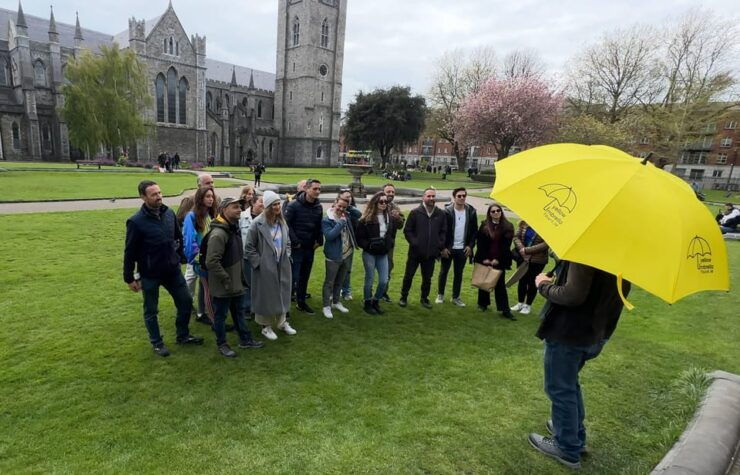
- Dublin’s origins trace back over 2,100 years to Celtic tribes who established a settlement on the banks of the River Liffey.
- Vikings arrived in the 9th century, recognizing Dublin’s strategic coastal value and leaving a lasting influence on the city’s culture and architecture.
- Normans left an architectural legacy with the construction of grand cathedrals and castles, including Christchurch Cathedral and Dublin Castle.
- Dublin served as the center of British rule and colonial governance, but also witnessed the rise of Irish nationalism and the struggle for independence.
- Dublin is renowned for its literary brilliance, with influential writers like James Joyce, Oscar Wilde, and Samuel Beckett, and its vibrant cultural and nightlife scene.
Dublin’s Celtic Origins
Dublin’s origins trace back over 2,100 years, when the region was first settled by Celtic tribes.
These early inhabitants established a settlement on the banks of the River Liffey, which they called "Dubh Linn" – the "black pool".
Over the centuries, the city grew as a hub of Celtic culture, with the Dubh Linn Garden becoming an important gathering place.
The Celtic people were known for their impressive metalwork, intricate knotwork, and vibrant oral traditions, all of which left a lasting mark on Dublin’s heritage.
As the city evolved, it would come to bear the influences of various invading forces, but its Celtic foundations remained a vital part of its identity.
Find more activities and experiences we've covered in Dublin.
Viking Conquest and Influence

Arriving in the 9th century, the Viking invaders were quick to recognize Dublin’s strategic value as a coastal settlement and trading hub. They established a longphort, or fortified settlement, and began raiding the surrounding lands. Over time, the Vikings integrated with the local Irish population, adopting certain customs and language. This Viking influence can still be seen in Dublin’s place names and architectural features, such as the Dubh Linn gardens where the Vikings moored their longboats. The Viking legacy is an integral part of Dublin’s rich history.
| Viking Conquest | Date | Significance |
|---|---|---|
| Arrival | 9th century | Established longphort, began raiding |
| Integration | Over time | Adopted local customs and language |
| Legacy | Present day | Evident in place names, architecture |
Norman Architecture and Legacy
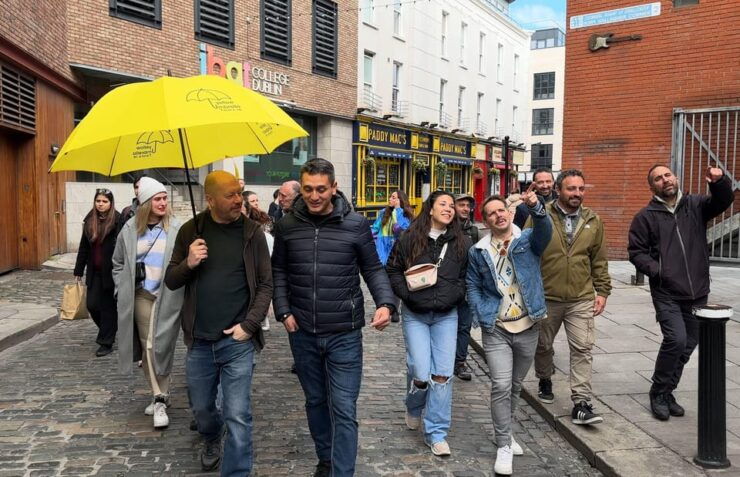
After the Viking conquest, the Normans arrived in Dublin, leaving a lasting architectural legacy across the city.
The Normans constructed grand cathedrals and castles, showcasing their power and influence. Christchurch Cathedral, originally built by Vikings, was reconstructed in stone by the Normans in the 12th century.
Similarly, St. Patrick’s Cathedral, the largest church in Ireland, was restored in the 1860s with the support of the Guinness family, reflecting the Normans’ ongoing impact.
Dublin Castle, the seat of British rule until 1922, features a mix of medieval and Georgian architecture, demonstrating the Normans’ architectural versatility and adaptability over the centuries.
British Rule and Resistance
For centuries, Dublin found itself at the center of British rule, as the city became the seat of colonial power and governance.
From the Norman conquest to the Act of Union, Dublin Castle served as the nerve center of British authority, housing administrators, soldiers, and policies that sought to subjugate the Irish populace.
However, this period also witnessed the rise of Irish nationalism and resistance:
- The 1798 Rebellion, led by the United Irishmen, sought to overthrow British rule.
- The Repeal movement, championed by Daniel O’Connell, pushed for the dissolution of the Act of Union.
- The late 19th century saw the emergence of Home Rule campaigns, demanding greater autonomy for Ireland.
- The 1916 Easter Rising marked a pivotal moment in the path towards Irish independence.
The Literary Brilliance of Dublin
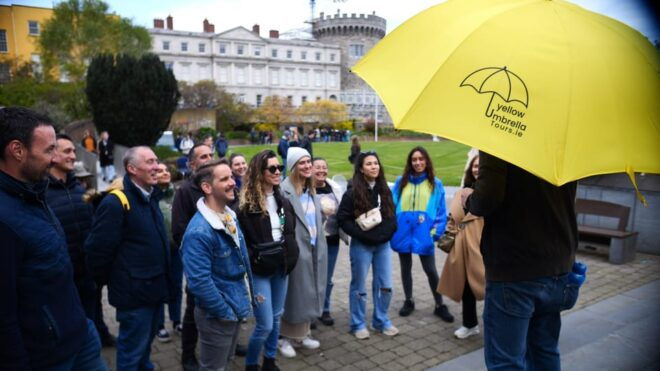
Dublin has long been celebrated as a literary powerhouse, producing some of the most brilliant and influential writers in the English language. From the masterful works of James Joyce and Oscar Wilde to the acclaimed novels of Bram Stoker and Samuel Beckett, Dublin’s literary legacy is unparalleled. The city’s vibrant cultural scene, rich history, and inspiring landscapes have captivated the imaginations of writers for centuries. As a testament to this literary brilliance, Dublin is home to numerous landmarks and events that honor its literary heritage, including the Dublin Book Festival, the James Joyce Centre, and the annual Bloomsday celebration.
| Writer | Notable Works | Influence |
|---|---|---|
| James Joyce | Ulysses, Dubliners | Pioneered modernist literature |
| Oscar Wilde | The Picture of Dorian Gray, The Importance of Being Earnest | Known for his wit and social commentary |
| Bram Stoker | Dracula | Popularized the vampire genre |
| Samuel Beckett | Waiting for Godot, Endgame | Awarded the Nobel Prize in Literature |
Dublin’s Cultural and Nightlife
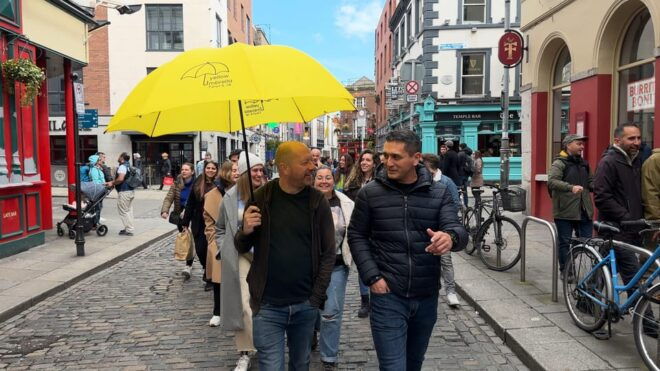
Pulsing with vibrant energy, Dublin’s cultural and nightlife scene captivates visitors from around the world.
From the lively pubs of Temple Bar to the cutting-edge arts venues, the city offers a diverse array of cultural experiences.
Travelers can enjoy the city’s rich heritage by exploring the:
- Vibrant street art adorning the city’s walls
- Traditional Irish music sessions in local pubs
- Eclectic array of galleries and museums
- Buzzing nightlife scene with live music and dance clubs
Dublin’s cultural tapestry is a testament to its resilient spirit, inviting visitors to discover the essence of this enchanting city.
The Modern Dublin Transformation
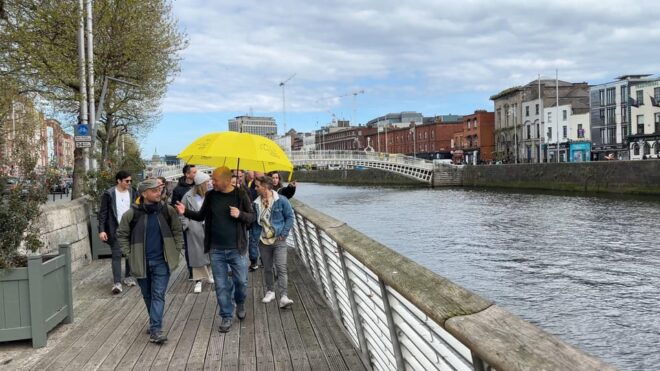
Over the past few decades, Dublin has undergone a remarkable transformation, evolving from a traditional European city into a vibrant, cosmopolitan hub. Fueled by the growth of the tech industry, the city has embraced modernity, with the Silicon Docks area now a thriving center of innovation.
Alongside this technological boom, Dublin has also seen a resurgence in its cultural scene, with new museums, art galleries, and performing arts venues popping up across the city.
While preserving its rich history and heritage, Dublin has seamlessly integrated contemporary elements, creating a unique blend that attracts visitors from around the world seeking an authentic Irish experience with a modern twist.
Exploring Dublin’s Top Attractions
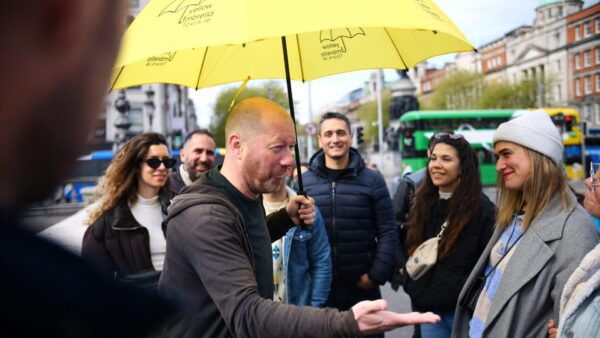
Amidst Dublin’s modern transformation, its top attractions continue to captivate visitors, offering a glimpse into the city’s rich history and vibrant culture.
From the iconic Christchurch Cathedral, with its Viking roots and neogothic architecture, to the stately Dublin Castle, the seat of British rule for centuries, these sites showcase the diverse influences that have shaped the city.
Visitors can explore the charming cobblestone streets of Temple Bar, enjoy the literary legacy of Trinity College, and pay homage to the renowned author Jonathan Swift at St. Patrick’s Cathedral.
These diverse landmarks, each with its own captivating story, make Dublin a truly remarkable destination.
Frequently Asked Questions
How Reliable Is the Tour Company’s Customer Feedback?
The tour company’s customer feedback appears reliable, with 5/5 overall rating and positive reviews praising the guide’s storytelling and the tour’s engaging and informative nature. Travelers recommend it as a great start to a Dublin trip.
Can I Customize the Tour to My Interests?
The tour company allows some flexibility to customize the tour to your interests. You can discuss your preferences with the guide when you meet to tailor the experience to your needs and focus on the locations that interest you most.
What Are the Payment Options for the Tour?
The tour offers flexible payment options – you can reserve your spot without payment and pay later, or you can pay upfront at the time of booking. Free cancellation is available up to 24 hours in advance.
Are There Any Discounts or Packages Available?
The tour doesn’t offer any discounts or packages, but there’s a "Reserve now & pay later" option that allows you to book your spot without payment upfront.
Can I Bring My Pet on the Tour?
No, pets are not allowed on this Dublin walking tour. The tour is focused on exploring the city’s key historical sites and landmarks, and does not accommodate bringing animals. Guests are advised to leave their pets at home.
The Sum Up
Dublin has evolved into a vibrant, cosmopolitan city that seamlessly blends its rich historical heritage with a thriving contemporary culture. The city’s Celtic roots, Viking influence, Norman architecture, and British legacy have all contributed to its unique charm and character. Today, Dublin shines as a renowned literary hub and cultural hotspot, inviting visitors to explore its diverse attractions and experience its captivating story.
You can check if your dates are available here:More Tour Reviews in Dublin
- Day trip to Cliffs of Moher, Bunratty Castle and Ennis
- Cliffs of Moher & Irish Cottage Industries Private Luxury Tour
- Private Transport /Transfers / Chauffeured Private Tour Ireland
- Waterford Crystal and Kilkenny City with Private Chauffeur Tour
- Transfers from Dublin Airport to Dublin City
- Arthurs Grand Canal Bike Tour
Looking for something different? Other Dublin activities we've written about
- Day trip to Cliffs of Moher, Bunratty Castle and Ennis
- Cliffs of Moher & Irish Cottage Industries Private Luxury Tour
- Private Transport /Transfers / Chauffeured Private Tour Ireland
- Waterford Crystal and Kilkenny City with Private Chauffeur Tour
- Transfers from Dublin Airport to Dublin City
- Arthurs Grand Canal Bike Tour
- Ancient Paths of Howth Village with a Local and his Dog
- The Private Walking Tour of Dublin
- 2 Hour Walking Tour of Dublin’s City Centre
- Dublin Food and Whiskey Tour
- Dublin City Ireland Self Guided Walking Audio Tour
- Dublin Airport to Ennis Private Premium Car Service
